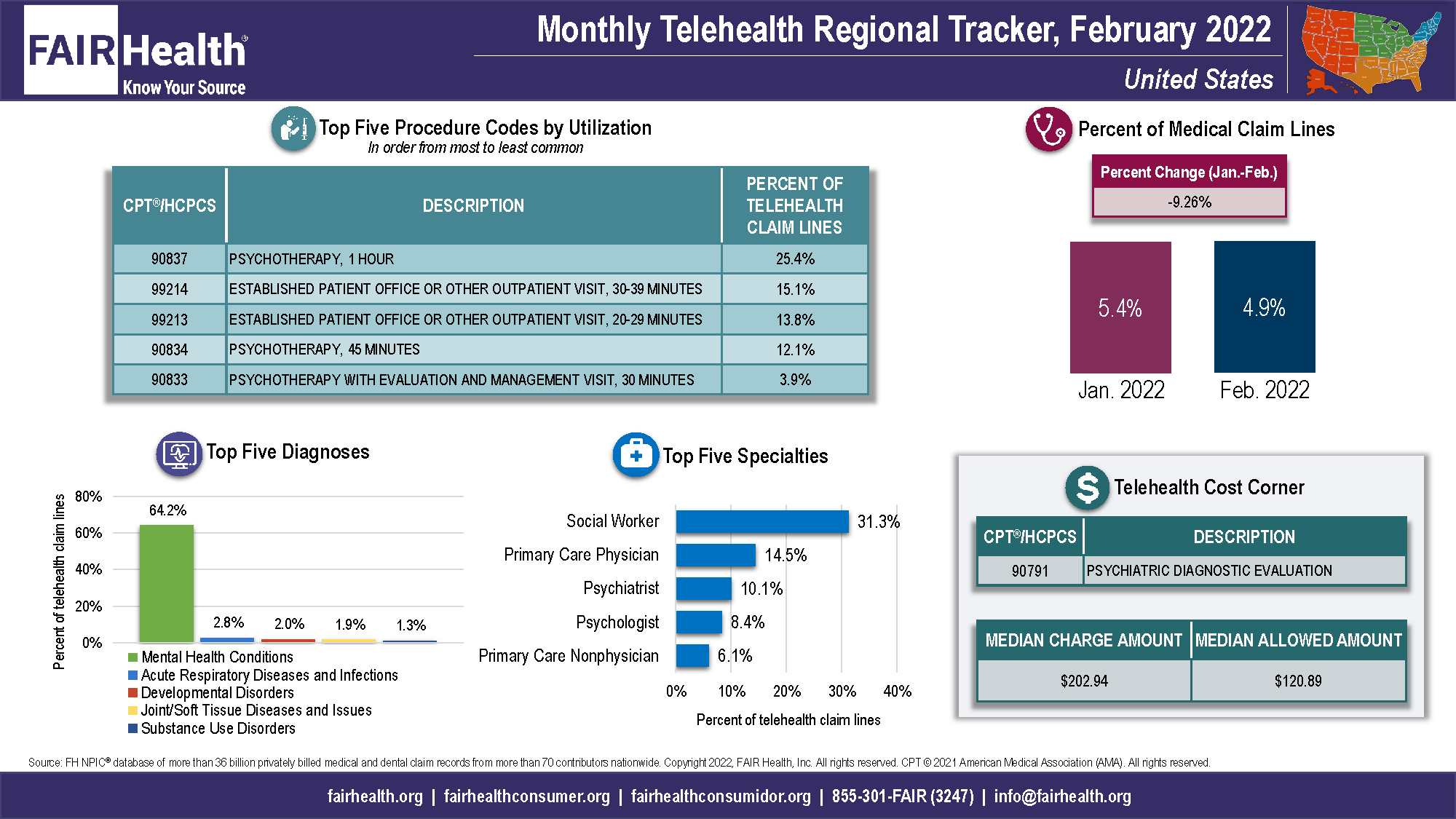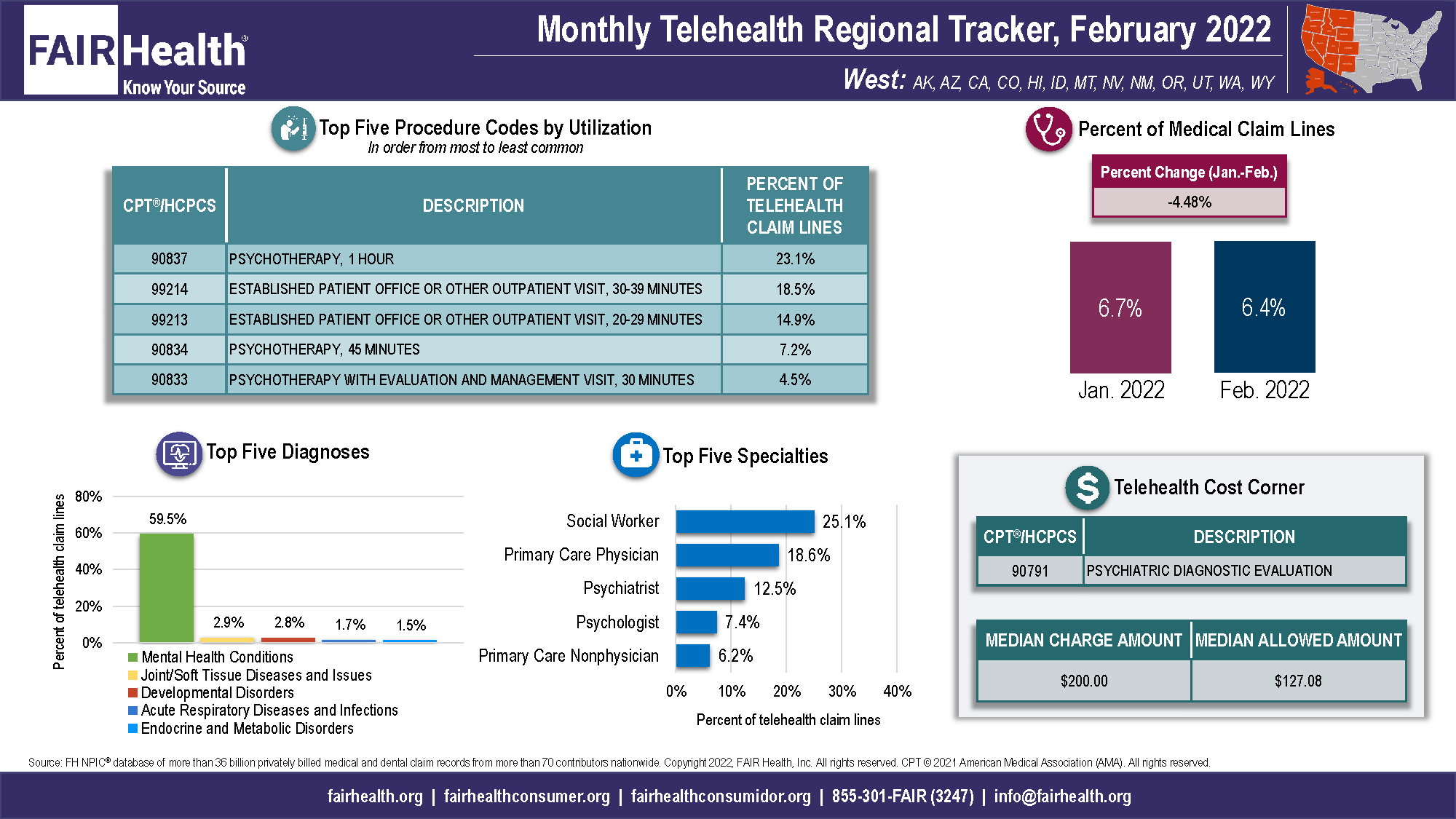Article
Contributor: COVID-19 Falls Out of Top 5 Telehealth Diagnoses in February 2022
Author(s):
The February drop out of the top 5 coincided with a sharp decline in new cases of COVID-19, as reported by the CDC, following the January peak of the wave of cases related to the Omicron variant.
After 2 months in the top 5 telehealth diagnoses nationally and in every US Census region, COVID-19 fell out of that ranking nationally and in every region in February 2022, according to FAIR Health’s Monthly Telehealth Regional Tracker. The change coincided with a sharp decline in new cases of COVID-19, as reported by the CDC, following the January peak of the wave of cases related to the Omicron variant. The FAIR Health data represent the privately insured population, including Medicare Advantage and excluding Medicare fee-for-service and Medicaid.
Following 3 months of growth, telehealth utilization declined 9.3% nationally in February 2022, from 5.4% of all medical claim lines in January 2022 to 4.9% in February (FIGURE 1). Telehealth utilization also decreased in February in every US Census region (Midwest, Northeast, South and West), with the greatest decrease (11.8%) in the Northeast. The drop in telehealth utilization was likely due to diminishing concerns about COVID-19 infection, which led more patients to return to in-person healthcare services.
FIGURE 1: Monthly Telehealth Regional Tracker, February 2022, United States
Credit: FAIR Health

Diagnoses
As COVID-19 dropped out of the top 5 telehealth diagnoses across the country in February 2022, other diagnoses rose to take its place. Substance use disorders reentered the top 5 nationally and in the Midwest and moved from fourth place to second place in the Northeast. Developmental disorders reentered the top 5 in the South. Endocrine and metabolic disorders reentered the top 5 in the West and joint/soft tissue diseases and issues moved from fourth place to second place. Mental health conditions continued to be the leading diagnosis everywhere, rising in percentage share of telehealth claim lines nationally and in every region. This increase may have been due in part to patients returning to in-person venues of care for diagnoses other than mental health conditions.
Specialties and Procedure Codes
In February 2022, social work became the most common specialty used for telehealth in the West, a position it continued to hold in every other region and nationally (FIGURE 2). Because the most common telehealth service social workers provide is psychotherapy, this trend was likely attributable to the increasing share of mental health conditions among telehealth diagnoses.
Similarly, in February 2022, the leading procedure code nationally and in every region, CPT 90837, 1 hour of psychotherapy, rose everywhere in its percentage share of telehealth claim lines.
FIGURE 2. Monthly Telehealth Regional Tracker, February 2022, West
Credit: FAIR Health

Costs
For February 2022, the Telehealth Cost Corner spotlighted the cost of CPT 90791, psychiatric diagnostic evaluation. Nationally, the median charge amount for this service when rendered via telehealth was $202.94, and the median allowed amount was $120.89.
About the Monthly Telehealth Regional Tracker
Launched in May 2020 as a free service, the Monthly Telehealth Regional Tracker uses FAIR Health data to track how telehealth is evolving from month to month. An interactive map of the four US census regions allows the user to view an infographic on telehealth in a specific month in the nation as a whole or in individual regions. Each infographic shows month-to-month changes in telehealth’s percentage of medical claim lines, as well as that month’s top five telehealth procedure codes, diagnoses and specialties. Additionally, in the Telehealth Cost Corner, a specific telehealth procedure code is featured, with its median charge amount and median allowed amount.
As the COVID-19 pandemic and telehealth utilization continue to evolve, FAIR Health’s Monthly Telehealth Regional Tracker serves as a window into that evolution. This is one of the many ways we pursue our healthcare transparency mission.
For the Monthly Telehealth Regional Tracker, click here.





